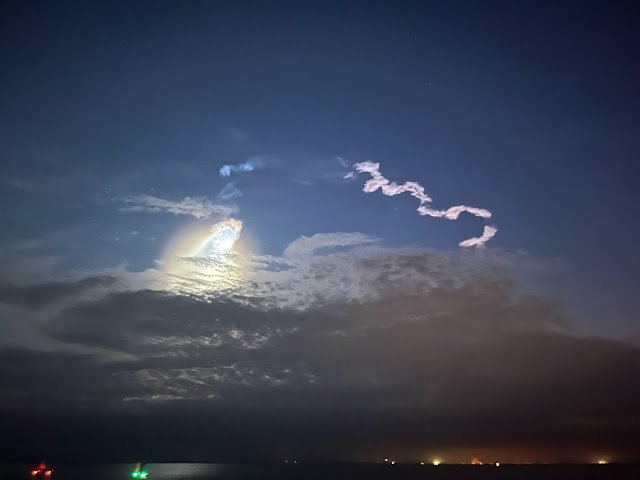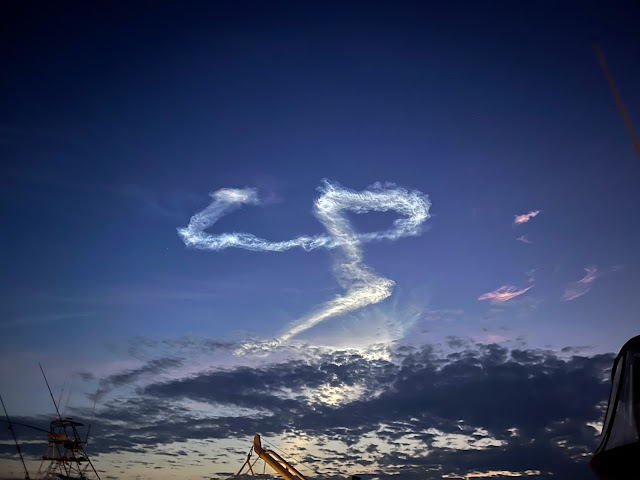 |
| The launch of the Skylink satellite lit up the pre-dawn sky. |
We last left readers with Molly in a broken arm in a beautiful purple cast. She is doing great, except that the cast can not get wet, and I have to do the dishes every
night. The cast comes off on May 27th. What we didn’t mention is that in the initial
rough passage on our trip back, one wave knocked our boat around and Molly flew
off the couch, breaking a big toe in the process. Not much you can do about a toe fracture, but
she is healing there nicely as well and is still able to go on walks, albeit a
little slower than her normal pace.
 |
| Melbourne Beach Fish Pier. |
 |
One of our anchorages was Manatee
Pocket, Port Solerno. |
Because we took advantage of a limited weather window, we returned from the Bahamas at least two weeks earlier than our original plan.
So, the time to cruise from West Palm to Daytona Beach, where we will pull out of the water on May 9
th, is now three weeks, not one week.
We have used that time to go slowly, and stay multiple days in the same marina or anchorage.
We have visited West Palm, North West Palm, Port Solerno, Fort Pierce, Vero Beach, Melbourne Beach, Indian Harbor Beach, Cape Canaveral, Titusville and Canaveral National Seashore.
 |
| Our dinghy motor conked out in Indian Harbor Beach, but I was happy to row and get the exercise. |
 |
We anchored off a spoils island in Cape Canaveral, which is a major cruise ship port in addition to being home to the
Kennedy Space Center. |
 |
We enjoyed our three days at Melbourne Beach, and here we are having cocktails on the bow while awaiting for a 5:30 pm
space launch. |
 |
All the beaches in Brevard County are closed to dogs, but many locals including someone in one town office said go ahead.
Tory had quality beach time in Melbourne Beach, Indian Harbor Beach and Cape Canaveral National Seashore. |
 |
We met long-term friends Rod
and Sheila Geant in Port Solerno.
Their friend Chris also joined us,
and she had a cast on just like Molly!
|
 |
Returning from the grocery store in Vero
Beach. |
We anchor out more than 50% of the time, but it can be a challenge at times as shore access is often limited (we need it for Tory!) and many otherwise desirable places are overrun with derelict boats.
Old Boats are dirt cheap and sometimes abandoned due to storm,only to be purchased or commandeered
 |
This boat hasn't moved in a while.. The
liveaboard has added tarps for
additional living space. |
by, typically, single males looking for cheap housing.
They flaunt local anchoring limitations, put
out every anchor they can find, and stay put for months, if not years, unless
their fortunes change.
 |
This boat was likely swamped here by
Hurricane Erma in 2017. |
Such boats likely number in the thousands, and the cost of
removal and disposal of just one boat, I have read, is as much as $500 per
foot.
This means that a typical sailboat
might cost up to $20,000 to remove.
The
Florida legislature has recently allocated $12 million, but it will require
millions more and increased enforcement to truly rid Florida of derelict boats.
Even then, it might only be good
enough until the next major hurricane.
 |
| Contrail from day-time launch. |
One of our bucket list items for this trip was to see a
rocket launch.
While we were able to
anchor right off Cape Canaveral, no launches were scheduled at that time.
Earlier, we did see a daytime launch from 25
miles away, interesting, but not too impressive.
Later we had the chance to witness a 5:42 am launch from the Kennedy Point Marina, about ten miles across the water from the launch site.
It was spectacular although the pictures don't do it justice.
Shortly after the rocket broke through the clouds it seemed to change projectory, and we could hear the rocket engines for the first time. Then a large white fireball become visible and grew immensely as the rocket accelerated away. We speculated that just prior to this, the rocket's first stage broke away, but we later learned it was the sun reflecting off the spent fuel. Our final picture (these were all taken by Molly!) shows the fascinating contrail visible some minutes after the rocket had disappeared.
Those of you who grew up in the 60’s will, no doubt,
remember the assassination of President Kennedy. Shortly after that tragic event, President
Johnson issued an Executive Order to change the name of Cape Canaveral to Cape
Kennedy, in honor of the President who had set the goal of landing on the moon. This was reversed in 1973 by the State of
Florida and Cape Canaveral once again was Cape Canaveral. The Space Center, however, continues to be
called the Kennedy Space Center.
Not sure if you will be able to view this video showing manatees slurping fresh water at the top of the salt water.
Another bucket item on our list was to once again see some manatees. These strange, large mammals are also called sea cows, although there was a time when sailors thought they were mermaids. Full-grown manatees typically weigh 800-1000 pounds and swim very slowly. They live their entire lives in shallow, coastal waters, coming up for air every 5 minutes or so. They are constantly feeding on aquatic vegetation of all types, often consuming plants equaling 5-10% of their body weight every day.
 |
We were watching some manatees thrash around in the water when a tour boat operator came by and told us that they
were mating. A bull manatee will typically have 6-8 females with him. |
 |
| While the bull manatee is doing his thing (upper right), the female appears to be either resting or waiting her turn. |
 |
Because of the heat we ended up staying at the Kennedy Point Marina as they have a great pool, and we found it a great
place to view a space launch and watch manatees. |
 |
| The white marks on this manatee were caused by a boat motor propeller blades. |
Manatees are defenseless creatures except they are protected
from alligators by their size and ability to hold their breath for up to 15
minutes.
Humans are their biggest
threat.
The State of Florida has many
protections for manatees as they were on the Endangered Species List until 2017.
These include low speed and no wake zones in
known manatee areas and the recent cultivation of new sea grass beds.
There are an estimated 7,500 manatees in
Florida.
We have now returned to Daytona Beach, and tomorrow we pull
Salty Paws out of the water and begin our slow trip back to Maine with more
visits to friends and family. It has
been quite a journey, and time will tell if this was our last trip to the
Bahamas.























Fantastic launch pics, our best times were also early evening ( although the one watched from a couple miles from the base at night was spectacular!). And loved your manatee video. Glad you're having such a wonderful cruise
ReplyDeleteHal here in Melrose. I am reading this on the morning of the 9th. If you are heading north today and pass near Palatka would be happy to meet you for lunch and chat. Very nice restaurant, Corky Bell's in East Palatka on the river. Text me at 904-651-4952. I could return Tory's red tennis ball he left here. By the way I renovated the stair case to my boat. Now has a railing and 12" deep stairs. Molly could not fall off again! At any rate, great blog. Happy trails!
ReplyDelete